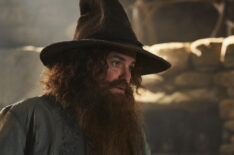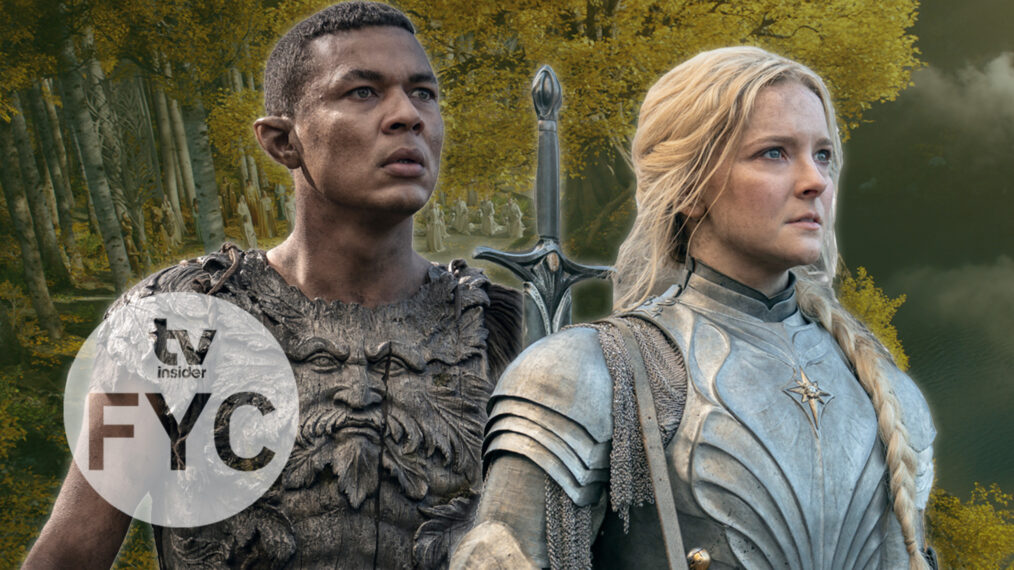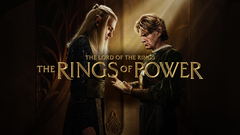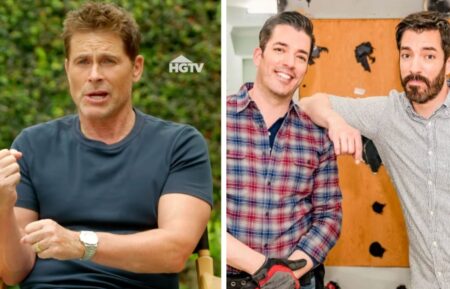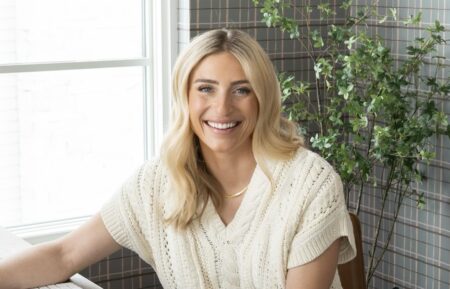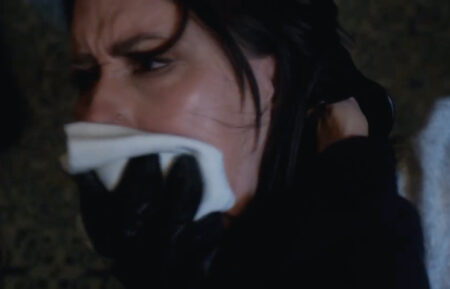Behind the Scenes of ‘The Lord of the Rings: The Rings of Power’ Season 2 & Its Villain’s Journey
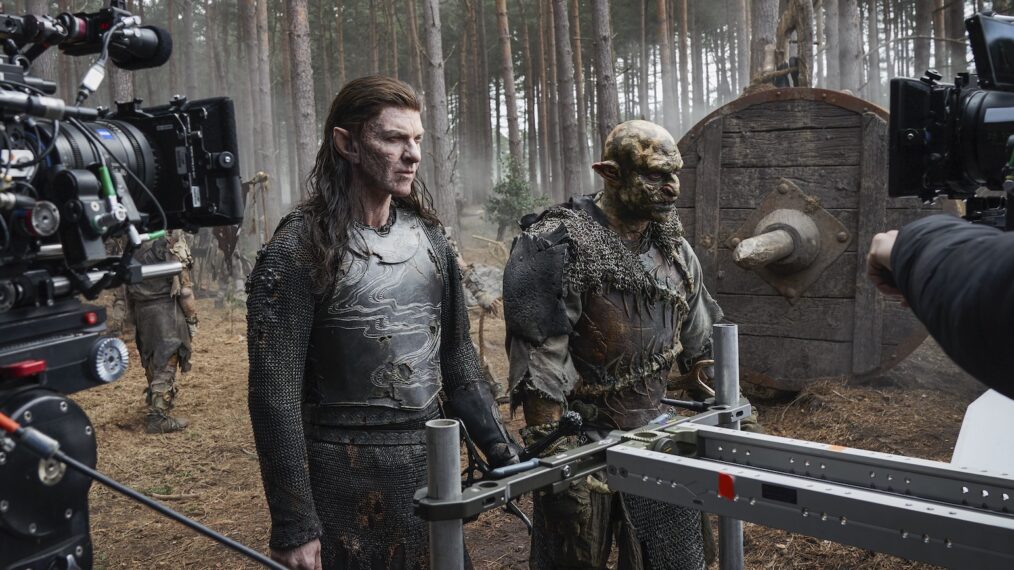
Preview
Whenever a new Lord of the Rings movie came out, my grandmother made a day of it. She’d treat me and my older sister to ice skating and lunch in preparation to sit in the icy theater for hours as Peter Jackson’s vision of Middle-earth unfolded. This was always followed by getting the extended edition four-disc DVD sets for Christmas, which occupied even more hours of my youth. This trilogy was the first film franchise I ever loved, and its battle sequences, specifically, made me wide-eyed with wonder. To watch Lord of the Rings on the big screen is to be transported directly into the fantasy. Now, imagine these memories flooding back as I was literally transported into The Lord of the Rings: The Rings of Power’s Middle-earth during a set visit for Season 2 in April 2023. I, along with a small and merry band of journalists, who are all longtime LOTR lovers, got to walk onto a battlefield where Elves and Orcs were crossing blades. The first thing I saw when stepping off of our van and into England’s Buttersteep Forest not long after sunrise was an Elf in full battle armor. The excited yelp I let out was involuntary.
They filmed in Bray Film Studios near Windsor, a lot that’s been home to films such as Alien, The Witches, and The Rocky Horror Picture Show. Our lodging was the Oakley Court Hotel. If you’ve seen Rocky Horror, you’ve seen this building; it was used as Frank-N-Furter’s castle in the film. From the journalists invited to our accommodations to what they showed us on set, it was the clear that this visit — which, because of COVID-19 restrictions in Season 1, marked the first time the series could welcome in any outsiders — was curated to feel special for lovers of TV and film history. There are few stories as historic as Lord of the Rings both in film and literature. The love for its predecessors is abundantly clear in every detail of how this Prime Video production is made.
The series moved its filming home from New Zealand to England this time around. What they lost in nearby mountain scenery they gained in proximity to more diverse landscapes, a necessity for a season that’s once again stretching out into more unseen corners of Middle-earth. If there’s one word to describe this season, it’s “more.” More evil. More action. More rings (make that a lot more). Our first dose of “more” came in the Orc makeup tent set up at Buttersteep Forest in Windsor Great Park. The tent was nestled in the trees, but just a few steps away was a massive muddy field with a towering white stone wall adorned with green flags with gold trim, seemingly from Eregion. We’d soon watch a stunt rehearsal and fight sequence filmed here with legendary stuntman Vic Armstrong (legendary is the most befitting word for the man who was Harrison Ford’s stunt double in Indiana Jones and is called the World’s Most Prolific Stuntman by Guinness World Records). But first, we learned how Orcs are made.
Prosthetics artists/married couple Barrie and Sarah Gower lead the prosthetics department this season. They’re modern legends of this craft. Stranger Things’ Vecna, Viserys’ deteriorating face in House of the Dragon, and the fungal zombies in The Last of Us are all recent creations from this Emmy-winning duo. Gower shares how they whittled down the time in the makeup chair from four to two-and-a-half hours per person between seasons. Using masks made of foam latex instead of silicone, she explains, drastically cuts down time while maintaining quality detail, and the lighter material is a godsend for actors who will be wearing these prosthetics all day. For the Orc actors with speaking roles, silicone prosthetics are used so the details hold up in closeups. All of them have bespoke Orc lenses and fake teeth (there are designated “tooth fairies” who tend to the dentures during food breaks).
All in all, Gower says they made “around 1,500 Orc makeups this season.” She and Barrie have made their fair share of prosthetics, and even so, between the Orcs and the Dwarves and other prosthetic needs, she says, “I don’t think there’s ever been a TV show that has done this volume of makeups.” After 10 years in the business, Gower says this “by far peaked anything we’ve done before.”
The plight of the Orcs becomes more sympathetic in Season 2. In fact, they seem downright gentle at times. They’re certainly comically harmless in their makeup chairs on this dewy April morning. We watched as the last few Orcs got their ears attached. One drank a smoothie to pass the time, while another read a Kindle and a third slept. Elsewhere on the lot, we by chance passed by an Orc taking a smoke break outside. Lord of the Rings fans, trust me when I say you haven’t lived until you’ve seen an Orc smoking a cigarette. And later in the day, we met Morfydd Clark, donning her full Galadriel armor and her face beaming, on a massive soundstage on which a sprawling Orc encampment had been built (see Clark in said tent with Sam Hazeldine‘s Adar below). We toured the tent and spoke with one Orc actor who has a special arc this season.
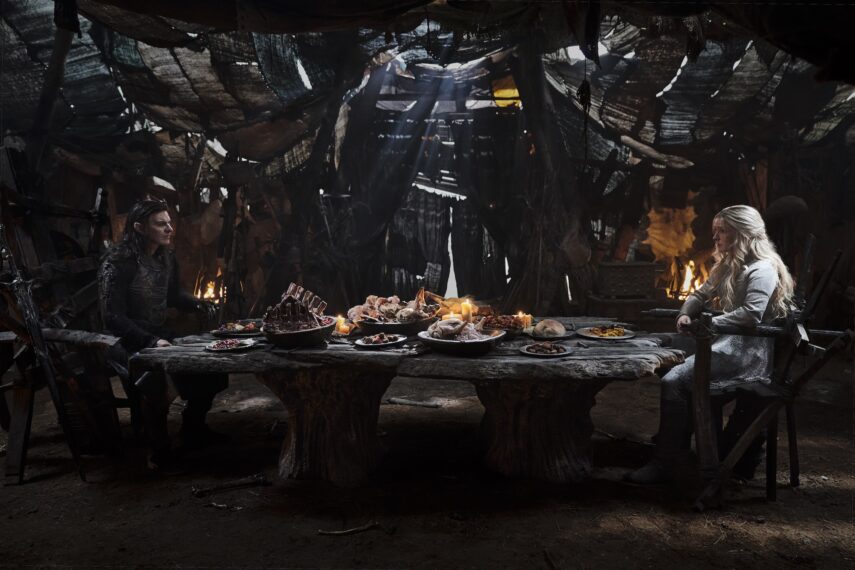
Adar (Sam Hazeldine) and Galadriel (Morfydd Clark) meet again in an Orc encampment (Ross Ferguson / Prime Video)
Back on the battlefield, we trekked into the muddy center of the action. Fake dead Orc and Elf bodies were strewn about. Arrows impaled the bodies and the earth. We walked across wooden slats through the graveyard, and just a few feet from these fake corpses were cardboard box lids holding iced coffees for the cast and crew. You’d think this would shatter the illusion of the deadly scene, but I was utterly charmed. I looked up to find a group of Orcs staring at us, the actors’ mouths unable to fully close because of the fake teeth. This caused my second involuntary yelp of the day. I was a kid in a candy store.
Along the tree line were two massive, functional trebuchets. We’re told that these historic English trees, which are part of the Windsor Crown Estate and are some of the oldest trees in the U.K., are some of the landscapes that inspired J.R.R. Tolkien’s writing. Filming among them is an added perk of moving to Europe. Stunt supervisor Ben Cooke gets down in the dirt with us and says to expect a lot more battle action from Elrond (Robert Aramayo), High King Gil-galad (Benjamin Walker), Isildur (Maxim Baldry), and Sauron (Charlie Vickers), who also appears in his fair form, Annatar, this season (see below). Clark’s Galadriel is a “badass” who’s “coming in hot” with her leveled-up action sequences, and she and Aramayo have a lot more horseback riding and hand-to-hand combat than before.
The other action superstar of this series, Ismael Cruz Córdova, spent four months training for an Arondir wire sequence. Elrond also has a major stunt that Aramayo performed himself. The scene we were standing in took Cooke eight weeks of work. He’s cheekily tight-lipped when I ask if any famous weapons from the books will be included in these clashes. “That I’m not sure of,” he says with a sly smile. But “as far as workload goes, we’re pinned,” he later adds. Part of that work includes production collaborating with the Windsor Crown Estate to leave this land better than they found it.
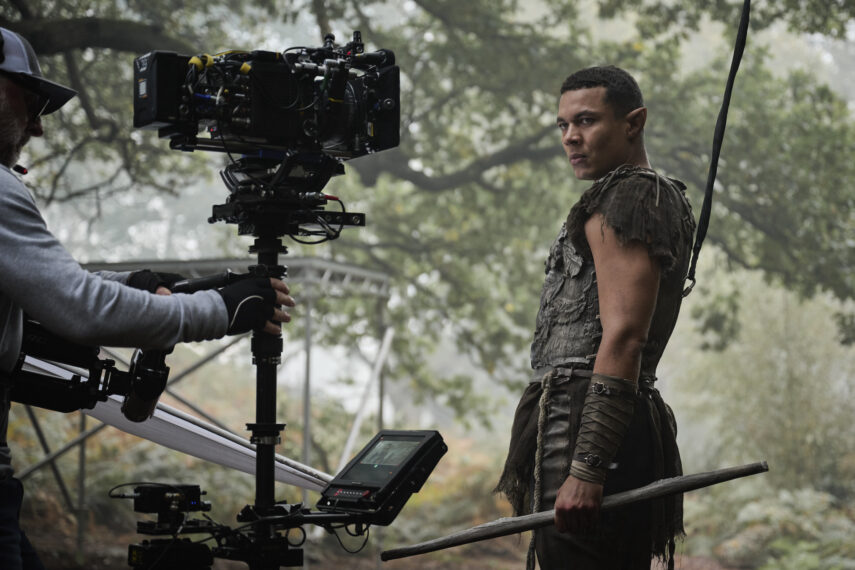
Ismael Cruz Córdova behind the scenes of The Lord of the Rings: The Rings of Power Season 2 (Ross Ferguson / Prime Video)
Armstrong, who’s directing this season, comes over wearing his signature Indiana Jones hat to chat before we watch some Orcs attack an Elf in a birds-eye view shot. This is just one frame from what will be a major battle scene. Chaos spreads quickly when Sauron returns, and the dark lord doesn’t even have to be present for this fire to catch. His roots are in everything, making Middle-earth a much darker place.
The roots of his current “Halbrand” form are explained in the season’s brutal opening scene, which showrunner J.D. Payne describes as “an Ides of March-esque” sequence that fellow showrunner Patrick McKay says will make you “pity” the dark lord. Surrounded by hand-painted storyboard art and 3D models of sets, the showrunners explain this opener in vivid detail at the start of our 45-minute group interview with the pair with pure glee on their faces. They, like our group, just love Tolkien.
They say that where Season 1 was the hero’s journey, Season 2 is the villain’s. And just as circumstances made Arondir, Bronwyn (Nazanin Boniadi, who is not returning for Season 2), and more rise to heroic heights, more characters will sink into villainy in this installment (premiering August 29). The showrunners previously said they weren’t interested in making “peak bleak” TV. How can that be avoided in a season that’s explicitly about the bad guys?
“Season 2 is darker because journeys have to go to darker places as they go forward,” McKay tells me. “Every saga that we love, that’s the classical structure. When we think about ‘peak bleak,’ it’s not necessarily about the level of the stakes or the scariness of it or whether people could die.” “It’s the core ethos at the center of it,” Payne chimes in.
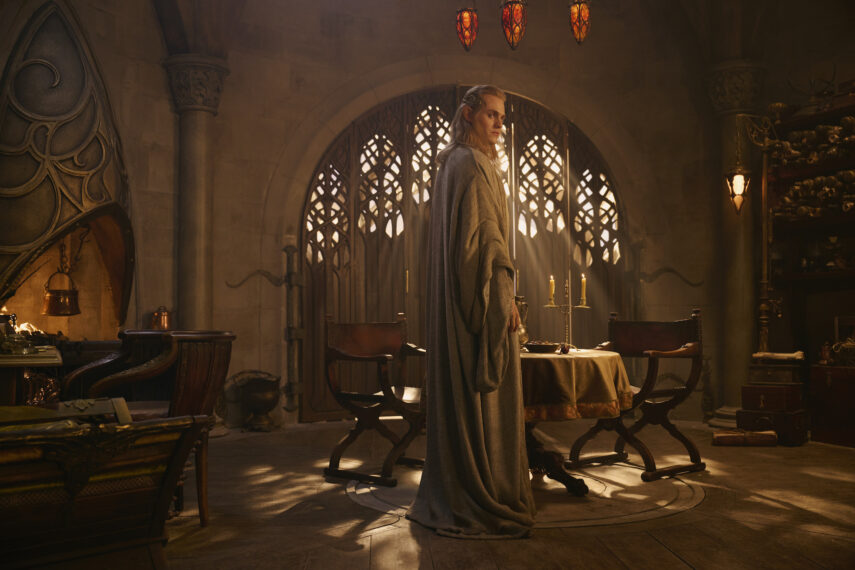
Charlie Vickers as Sauron/Annatar in The Lord of the Rings: The Rings of Power Season 2 (Ross Ferguson / Prime Video)
“Is it nihilistic, bleak, or cynical where people are screwing each other over for their own self-gain without any sense of redemptive quality at the center of it?” Payne says. “In Tolkien, even the villains often have something redemptive at the center. Even Sauron in his own twisted way thinks he’s healing Middle-earth.” Even Orcs want a safe place to call home. As McKay adds, “There’s an earnestness to Middle-earth, and we happily embrace that. It’s really hip to be cynical and roll your eyes and be postmodern, and we’re just not going to play that game.”
The villains’ journey is about “understanding [Sauron’s] psychology and how he works,” McKay explains. On Sauron’s quest to forge more rings, Payne says “we’re going to watch as he uses deception, manipulation, lies, coercion, cunning to set the chess pieces in motion.” He adds that “watching him be gleefully manipulative in his game is a lot of fun.”
Much of this season is spent showing why the bad guys do what they do, but also how Sauron’s influence is connected to all of it even from afar. “We saw in Season 1 that Galadriel, who in our estimation is one of the great heroes of Middle-earth, her pride and her PTSD were a crack that [Sauron] could get into and manipulate her to get everything he wanted,” McKay says. “Now, he’s going to do that with everybody.”
“Every single one of these societies and heroes that we set up in Season 1 are now facing serious cracks in the foundation that Sauron can exploit,” McKay adds, “This is not a story about several different worlds. This is a story about one world, and Sauron is the spine that connects all of it.”
The people of Númenor, Khazad-dûm, and the former Southlands are all having to “reckon with the evil that is inside them,” Payne notes. Indeed, Cynthia Addai-Robinson tells us that Númenor is dangerously divided upon her return from the unpopular war, and Miriel will struggle to navigate the chasm. Her biggest threat are those who have been “corrupted in a quest to gobble up power” in her island kingdom.
Conversely, Trystan Gravelle (Pharazôn) tells me that there’s “a cleaning up of the image of Númenor after what’s happened,” and he takes it upon himself to do the cleaning. But “do ends justify means?” Gravelle wonders. Get an exclusive look at Pharazôn as he makes his plans with son Kemen (Leon Wadham) in the court of Númenor below. This towering room is another set we had the pleasure to tour. It’s as big and grand as it seems. You can’t help but feel you’ve left reality when standing in the center of it.

Kemen (Leon Wadham) and Pharazôn (Trystan Gravelle) in the court of Númenor (Ross Ferguson / Prime Video)
There’s some corrupting force for every Middle-earth society this season. For the Dwarves of Khazad-dûm and Elves of Eregion, “it’s about greed,” according to art director Kristian Milstead. Owain Arthur tells us that Durin is still struggling to reconcile with his father, King Durin (Peter Mullan). While the disowned prince tries to expand and improve the lives of his people, conflict and darkness are still brought to his homeland and the neighboring Eregion where Celebrimbor’s (Charles Edwards) new and improved ring forge lives.
The biggest threat this season is just how good Sauron is at accomplishing his goals. The oppressive forces of evil are reflected in every aspect of the set design, from the set pieces themselves to the lighting and the hand-painted backdrops (green screen backgrounds were avoided as much as possible). It will take all of the corners of Middle-earth coming together to defeat this ultimate foe, but things are going to get a lot worse before they get better.
The Lord of the Rings: The Rings of Power, Season 2 Premiere, Thursday, August 29, Prime Video
From TV Guide Magazine
What to Expect From 'The Hunting Party's Love Triangle and Mystery
Manifest alum Melissa Roxburgh and the showrunner of NBC’s Hunting Party tease TV Guide Magazine about what’s ahead for the “government conspiracy that just keeps unfolding” — plus, the series’ “good” love triangle. Read the story now on TV Insider.

